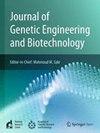A convenient viral transduction based method for advanced multi-engineering of primary human (CAR) T-cells
IF 3.5
Q3 Biochemistry, Genetics and Molecular Biology
Journal of Genetic Engineering and Biotechnology
Pub Date : 2024-12-01
DOI:10.1016/j.jgeb.2024.100446
引用次数: 0
Abstract
The past decades have illustrated the power of T-cell engineering in the development of new and successful cell therapies, such as chimeric antigen receptor (CAR) T-cells. Despite clinical success in hematological malignancies, it also becomes increasingly clear that additional T-cell engineering will be required to improve efficacy and safety and expand the application to solid tumors. Engineering is most often achieved by viral delivery of transgenes, however, viral vector capacity limitations make efficient and reproducible generation of multi transgene expressing T-cell therapeutics technically challenging. We here describe a convenient and efficient method for the delivery of up to three γ-retroviral CAR vectors in T-cells. We achieved this using virus vector mixtures that are simultaneously produced at high titers by double- or triple- transduced stable virus producer cells. We show that this method is superior in overall efficiency and reproducibility to conventional double or triple CAR transductions, in which separate viral batches are used. Due to its robustness, this method can facilitate the research and the development for advanced T-cell engineering towards more effective and safe therapies.
一种便捷的基于病毒转导的原代人(CAR) t细胞高级多工程方法
过去的几十年已经证明了t细胞工程在开发新的和成功的细胞疗法方面的力量,例如嵌合抗原受体(CAR) t细胞。尽管在血液系统恶性肿瘤方面取得了临床成功,但越来越清楚的是,需要更多的t细胞工程来提高疗效和安全性,并将其应用于实体肿瘤。工程通常是通过病毒传递转基因来实现的,然而,病毒载体容量的限制使得高效和可重复地产生多转基因表达t细胞疗法在技术上具有挑战性。我们在这里描述了一种方便和有效的方法,可以在t细胞中递送多达三种γ-逆转录病毒CAR载体。我们使用病毒载体混合物实现了这一目标,该混合物同时由双导或三导稳定的病毒产生细胞以高滴度产生。我们表明,这种方法在总体效率和可重复性方面优于传统的双或三CAR转导,其中使用单独的病毒批次。由于其稳健性,该方法可以促进先进t细胞工程的研究和发展,以实现更有效和安全的治疗方法。
本文章由计算机程序翻译,如有差异,请以英文原文为准。
求助全文
约1分钟内获得全文
求助全文
来源期刊

Journal of Genetic Engineering and Biotechnology
Biochemistry, Genetics and Molecular Biology-Biotechnology
CiteScore
5.70
自引率
5.70%
发文量
159
审稿时长
16 weeks
期刊介绍:
Journal of genetic engineering and biotechnology is devoted to rapid publication of full-length research papers that leads to significant contribution in advancing knowledge in genetic engineering and biotechnology and provide novel perspectives in this research area. JGEB includes all major themes related to genetic engineering and recombinant DNA. The area of interest of JGEB includes but not restricted to: •Plant genetics •Animal genetics •Bacterial enzymes •Agricultural Biotechnology, •Biochemistry, •Biophysics, •Bioinformatics, •Environmental Biotechnology, •Industrial Biotechnology, •Microbial biotechnology, •Medical Biotechnology, •Bioenergy, Biosafety, •Biosecurity, •Bioethics, •GMOS, •Genomic, •Proteomic JGEB accepts
 求助内容:
求助内容: 应助结果提醒方式:
应助结果提醒方式:


